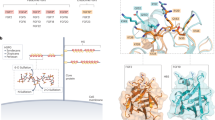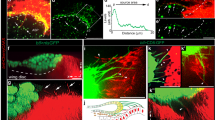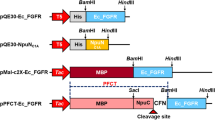Abstract
Basic fibroblast growth factor (bFGF) is a potent growth and angiogenic factor that is found in abundance in tissues such as brain, hypothalamus, kidney and cartilage1,2. Despite this copious production of bFGF, most of these tissues are not undergoing either active growth or angiogenesis, suggesting that bFGF activity must be regulated so as to prevent autostimulation of cell growth. In cultured cells, bFGF is associated mainly with cells and basement membranes and is not released into the medium3,4. Prevention of release could be a mechanism for regulation of bFGF activity and may be a consequence of the apparent absence of a secretory-signal sequence in the bFGF protein5. Here we investigate whether this regulation can be overridden through the forced secretion of bFGF. Such secretion might provide the bFGF access to its receptor and in turn lead to autocrine transformation of the cell. We report that bFGF, as specified by a recombinant plasmid, is itself unable to induce such transformation, but acquires this ability after fusion with a secretory-signal sequence. The resulting transformants undergo unusual morphological alteration and display tumorigenicity.
This is a preview of subscription content, access via your institution
Access options
Subscribe to this journal
Receive 51 print issues and online access
$199.00 per year
only $3.90 per issue
Buy this article
- Purchase on SpringerLink
- Instant access to full article PDF
Prices may be subject to local taxes which are calculated during checkout
Similar content being viewed by others
References
Folkman, J. & Klagsbrun, M. Science 235, 442–447 (1987).
Baird, A. et al. Recent Progress in Hormone Research 42, 143–205 (1986).
Klagsbrun, M., Sasse, J., Sullivan, R. & Smith, J. A. Proc. natn. Acad. Sci. U.S.A. 83, 2448–2452 (1986).
Vlodavsky, I. et al. Proc. natn. Acad. Sci. U.S.A. 84, 2292–2296 (1987).
Abraham, J. A. et al. Science 233, 545–548 (1986).
Loh, D. Y., Bothwell, A. L. M., White-Scharf, M. E., Imanishi-Kari, T. & Baltimore, D. Cell 33, 85–93 (1983).
Stern, D. F., Hare, D. L., Cecchini, M. A. & Weinberg, R. A. Science 235, 321–324 (1987).
Smotkin, D., Gianni, A. M., Rozenblatt, S. & Weinberg, R. A. Proc. natn. Acad. Sci. U.S.A. 72, 4910–4913 (1975).
Southern, P. J. & Berg, P. J. molec. appl. Genet. 1, 327–332 (1982).
Ziegler, S. F., Whitlock, C. A., Goff, S. P., Gifford, A. & Witte, O. N. Cell 27, 477–486 (1981).
Leal, F., Williams, L. T., Robbins, K. C. & Aaronson, S. A. Science 230, 327–330 (1985).
Robbins, K. C., Leal, F., Pierce, J. H. & Aaronson, S. A. EMBO J. 4, 1783–1792 (1985).
Betsholtz, C., Westermark, B., Ek, B. & Heldin, C.-H. Cell 39, 447–457 (1984).
Lang, R. A., Metcalf, D., Gough, N. M., Dunn, A. R. & Gonda, T. D. Cell 43, 531–542 (1985).
Rettenmier, C. W. et al. Molec. cell. Biol. 7, 2378–2387 (1987).
Watanabe, S., Lazar, E. & Sporn, M. B. Proc. natn. Acad. Sci. U.S.A. 84, 1258–1262 (1987).
Rosenthal, A., Lindquist, P. B., Bringman, T. S., Goeddel, D. V. & Derynck, R. Cell 46, 301–309 (1986).
Finzi, E. et al. Proc. natn. Acad. Sci. U.S.A. 84, 3733–3737 (1987).
Dickson, C. & Peters, G. Nature 326, 833 (1987).
Taira, M. et al. Proc. natn. Acad. Sci. U.S.A. 84, 2980–2984 (1987).
Marx, J. L. Science 237, 602–603 (1987).
Laemmli, U. K. Nature 227, 680–685 (1970).
Author information
Authors and Affiliations
Rights and permissions
About this article
Cite this article
Rogelj, S., Weinberg, R., Fanning, P. et al. Basic fibroblast growth factor fused to a signal peptide transforms cells. Nature 331, 173–175 (1988). https://doi.org/10.1038/331173a0
Received:
Accepted:
Published:
Issue date:
DOI: https://doi.org/10.1038/331173a0
This article is cited by
-
Conventional and unconventional secretory proteins expressed with silkworm bombyxin signal peptide display functional fidelity
Scientific Reports (2017)
-
Establishment of clival chordoma cell line MUG-CC1 and lymphoblastoid cells as a model for potential new treatment strategies
Scientific Reports (2016)
-
Thrombospondin-1 repression is mediated via distinct mechanisms in fibroblasts and epithelial cells
Oncogene (2015)
-
Pro-angiogenic cytokines and their role in tumor angiogenesis
Cancer and Metastasis Reviews (2006)
-
Direct FGF receptor 1 activation through an anti-idiotypic strategy mimicks the biological activity of FGF-2 and inhibits the progression of the bladder carcinoma derived from NBT-II cells
Oncogene (2004)



